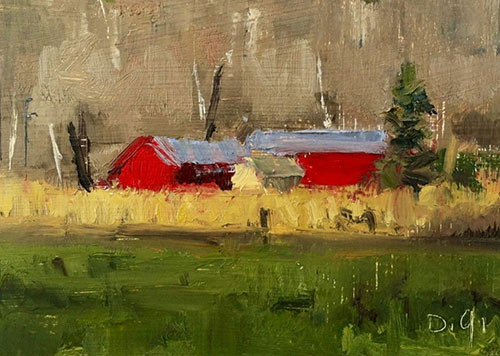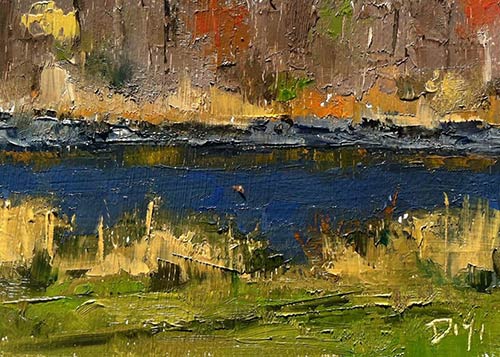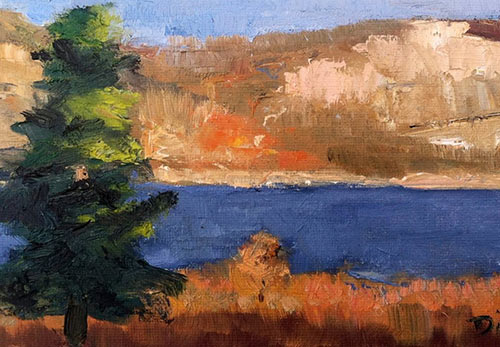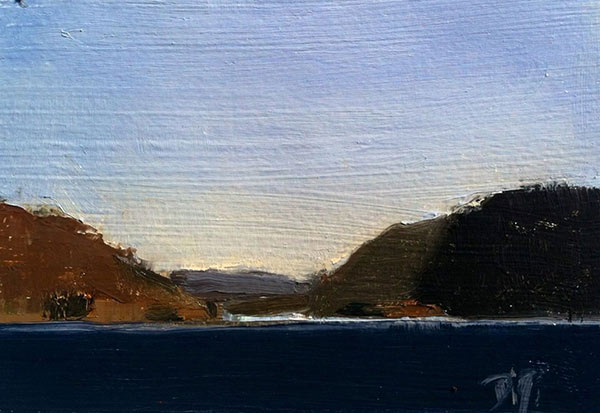New York painter Amy DiGi has some reasons for painting in oil on 5”-x-7” sheets of paper. And they all make sense.
Lead Image: One of Amy DiGi’s 5”-x-7” oil paintings on paper
First, and especially at this time of year, she’s in a lot of small-works shows. People like to give paintings during the holidays, and small pieces sell well. “I also donate a lot of work around this time of year, so smaller is better for me,” she says. But when it comes to framing pieces, the flatter the better. “If I work on canvas panels, I lose 1/8” of it to the lip of the French easel, or I have to balance it in one hand while trying to paint it with the other hand. Some make contraptions to hold the panels, but that’s not me. The French easel is enough of a contraption. And if I try to stretch canvas at that size, I always get a bump in one of the corners. If you have larger stretchers, the longer pieces of wood can absorb the inconsistencies. Paper is flat and clean. I cut my own mats, and the presentation is improved so much by using paper.”
DiGi tapes a piece of paper to Fome-Cor and paints several compositions on it, then cuts them out when she gets home. But how does the surface take the oil paint? DiGi starts with Rives BFK printmaking paper — she was a printmaker for several years — and primes it. She’s very comfortable working with paper.

The small size appeals to her for a couple more reasons. “It’s many starts,” says DiGi. “It’s the whole idea of filling miles and miles of canvas. If I keep doing this, I am educating myself quickly. I’m not patient. I want to learn. The alternative is going to one spot two or three times to finish. And I don’t like working on a piece back in the studio. To me, the minute I take a plein air painting inside, it becomes broken. There are no birds, no wind, no clouds to come and change the scene.”

Of course, DiGi does work on larger pieces, and she will return several times to a location to finish it en plein air. Even then, the 5”-x-7” format may get some play. “I will finish the big piece and have the board out with me so I can investigate other scenes while I’m there. The longer I’m in a space, the more I fall in love with other scenes at the location.”

Lastly, the small format has proved to be a revelation in regard to the use of a palette knife. “I am in love with my palette knife,” says DiGi. “Before, I only used it to deal with edges, not for paint application. I used brushes. But now I apply paint with my knife, and the small size works for me. To do an entire big painting with a palette knife sounds really daunting for me, but I’ve started to use it on bigger pieces. With the smaller format, I had to use small brushes, even loaded up, so by the time I touched the surface a bit I had to reload. With the knife I can be accurate, I can paint skinny, narrow lines, or I can get a lot on. It does the trick; it does it well. Plus, mixing colors with a palette knife is more accurate than mixing with a brush because you avoid dirty brushes. Wipe the knife, and it gets very clean. Before, I had as many as a dozen brushes in my other hand.”





I love Amy’s work and her methods. I’m excited to read this article because it reminds me of methods I’ve used in the past and inspires me to return to painting on paper with oils, as well as the small size. My M O is very similar – I only paint with the knife – so I have now gotten enthused about returning to some of my favorite places to do some small paintings. Thank you, Outdoor Painter!